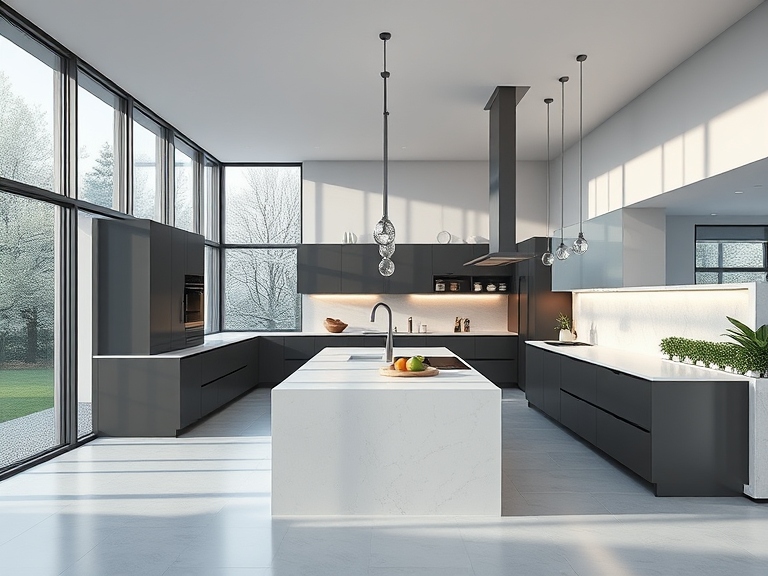
IKEA kitchens have gained immense popularity in recent years, primarily due to their modern aesthetics and functionality. Catering to a wide array of design preferences, these kitchens offer a versatile range of options suitable for any home, from compact apartments to spacious family residences. The primary appeal of IKEA kitchens lies in their combination of affordability and style, making them a go-to choice for homeowners aiming to enhance their living space without exceeding their budget.
The affordability of IKEA kitchens does not mean compromising on quality. Instead, the brand emphasizes a philosophy of efficient design and production, ensuring that consumers receive value for their investment. The variety of designs, from classic to contemporary, allows individuals to create a personalized kitchen that reflects their unique tastes. Additionally, IKEA boasts an extensive selection of accessories and features that enable homeowners to customize their kitchen layouts, enhancing both aesthetics and functionality.
However, achieving the best results with an IKEA kitchen installation requires careful planning and execution. While the products are user-friendly and often marketed as DIY-friendly, the intricacies of proper installation can be challenging for the untrained eye. A professional installation of IKEA kitchens not only ensures that every component is accurately fitted but also maximizes the kitchen’s usability and longevity. By hiring experts, homeowners can avoid common pitfalls and mistakes that may arise during the self-installation process.
The integration of quality materials and thoughtful design has cemented IKEA’s standing in the kitchen market. As more individuals recognize the benefits of IKEA kitchens, the potential for customization and modern living continues to attract a diverse clientele. This guide aims to delve deeper into the aspects of IKEA kitchen installation from a professional perspective, highlighting essential considerations for creating the kitchen of your dreams.
Preparing for Installation: Planning and Design
When embarking on an IKEA kitchens installation from a professional, proper planning and design play a crucial role in the overall success of the project. Before any installation takes place, homeowners must thoroughly assess their kitchen space to ensure a seamless fit for the proposed elements. This begins with accurate measurements, as any discrepancies can lead to complications later in the process. Ensure to measure the height, width, and depth of the space, including any obstructions like windows, doors, and plumbing fixtures. Documenting these dimensions will provide a reliable reference for your design.
Next, selecting the right layout is essential for maximizing the efficiency of the kitchen. Consider the dimensions of the workspace and the workflow within the kitchen. The classic kitchen work triangle—comprising the stove, sink, and refrigerator—should be functional and unobstructed. Depending on the space available, opt for a layout that complements your cooking and lifestyle habits, such as L-shaped, U-shaped, or galley kitchens. Additionally, envision how you and your family use the kitchen to determine the ideal traffic flow and accessibility.
Once the layout is established, it is time to choose kitchen elements that blend both style and functionality. IKEA offers myriad options for cabinetry, countertops, and storage solutions. Prioritize quality materials that withstand the daily wear and tear and consider aesthetic elements that align with your vision. Incorporating various textures and colors can elevate the design while ensuring practicality.
Incorporating the expertise from a professional is valuable during this stage. They can offer insights into the best practices for an effective kitchen workflow, ensuring that the design not only looks good but also functions efficiently. With careful planning and design, your IKEA kitchen installation can become an enjoyable and transformative experience.
The Importance of Professional Installers for IKEA Kitchens
When considering IKEA kitchens installation from a professional, it is essential to recognize the significant advantages that hiring skilled installers provides. These professionals possess not only a deep understanding of the intricacies involved in the assembly and fitting of IKEA kitchens but also the expertise to efficiently navigate the inherent challenges that can arise during the installation process. Professional installers are trained to ensure that each component, from cabinets to fixtures, is meticulously aligned and secured, which is crucial for both aesthetics and functionality.
One of the key benefits of using professional installers is their extensive experience in managing complex kitchen layouts and understanding spatial arrangements. A professional can effectively assess your kitchen’s unique dimensions and architectural features, ensuring that the IKEA kitchen elements are appropriately configured. Furthermore, skilled installers possess knowledge of best practices, allowing them to avoid common pitfalls associated with DIY projects, such as miscalculations and incorrect installations that can lead to costly reworks.
Additionally, professionals are well-versed in the various safety standards and building codes applicable to kitchen installations. This knowledge is crucial to guarantee that your kitchen not only looks great but is also safe to use. A certified installer is aware of the necessary precautions to take during the process, such as ensuring that plumbing and electrical components are correctly managed. Overall, hiring skilled professionals greatly enhances the likelihood of a successful and trouble-free IKEA kitchens installation.
By entrusting your kitchen installation to knowledgeable professionals, you alleviate the stress and uncertainty associated with DIY projects. Their ability to deliver quality work while adhering to safety regulations underlines the importance of opting for professional assistance in your kitchen renovation journey.
Key Tools and Materials for Installation
When embarking on the installation of IKEA kitchens, it is essential to equip oneself with the right tools and materials to ensure a smooth and efficient process. The common tools that professionals typically use include a power drill, a level, a tape measure, and a rubber mallet. Each of these tools plays a crucial role in the precise setup of kitchen units, which are fundamental when it comes to creating a functional and aesthetically pleasing space. Additionally, a set of screwdrivers, both flathead and Phillips, will be necessary for assembling cabinetry and fixtures.
For a more specialized installation, professionals may also incorporate additional equipment such as a jigsaw, which is beneficial for cutting cabinet fronts or countertops to fit in unique spaces. A circular saw might be necessary for larger sheets of plywood or MDF, which can be used to create customized storage solutions. It is also advisable to have a stud finder, particularly for wall-mounted cabinets, to guarantee they are anchored securely.
The types of materials you will encounter during IKEA kitchens installation are predominantly manufactured from high-quality wood products, such as particleboard and medium-density fiberboard (MDF). These materials are often covered with a laminated finish that not only enhances durability but also offers a range of colors and textures to complement various interior designs. Understanding the significance of these materials is critical, as they contribute to the overall functionality and longevity of the kitchen. Proper installation of IKEA kitchens requires careful attention to detail in both tool selection and material usage, ultimately leading to a kitchen space that is both stylish and practical.
Step-by-Step Installation Process
Installing an IKEA kitchen can be an exciting yet complex endeavor. Understanding the step-by-step process allows homeowners to effectively manage their time and expectations. The first stage involves assembling the cabinets. This is a crucial step, as cabinets form the backbone of any kitchen layout. Utilize the provided instruction manuals, ensure you have the necessary tools, and pay attention to the dimensions specified to optimize space utilization.
Once the cabinets are assembled, the next step is to secure them to the wall. This involves identifying the correct wall studs and using appropriate anchors. A level is essential here, as it guarantees that the units are aligned correctly, preventing any future issues with uneven surfaces. Attaching the cabinetry typically requires two to four hours, depending on the number of cabinets and the complexity of the layout.
The installation of countertops follows cabinet assembly. IKEA offers several options, including laminate and solid wood tops. Prior to installation, take accurate measurements to ensure a snug fit. Cutting countertops may require specialized tools, and it is advisable to seek help from professionals to avoid errors. Countertop installation can typically take three to five hours, depending on the type and design selected.
Next, attention turns to plumbing and electrical work. Installation of sinks and appliances, such as refrigerators and dishwashers, requires careful plumbing arrangements to prevent leaks. If unfamiliar with plumbing or electrical systems, contacting a professional for assistance is highly recommended to ensure compliance with local codes. Don’t overlook time for inspections if applicable—this can add several days to your timeline.
Lastly, finishing touches such as cabinet doors, hardware installation, and the application of caulk complete the kitchen. Thoroughly review each step to identify potential challenges and equip yourself with solutions ahead of time. Effective planning and executing these steps meticulously are crucial to a successful IKEA kitchens installation from a professional perspective.

Common Challenges During Installation
The installation of an IKEA kitchen can be a rewarding yet challenging experience, especially for those without prior experience in cabinetry assembly and installation. One common issue that often arises is dealing with uneven floors. Many homes, particularly older ones, may not have perfectly level surfaces, leading to complications in properly fitting cabinets. Professional installers typically address this challenge by utilizing shims to adjust the height of the cabinets, ensuring they are even and perfectly aligned with one another. This technique not only contributes to a visually appealing finish but also prevents future complications with doors and drawers.
Another frequent hurdle during IKEA kitchens installation from a professional is handling incorrect measurements. It is essential to accurately measure the space before purchasing your kitchen components. Professionals recommend double-checking all measurements before beginning the installation process, as even a small error can lead to significant adjustments down the line. In situations where measurements don’t align, professionals may utilize cabinetry fillers or trim pieces to create a seamless transition, ensuring a polished appearance.
Proper door alignment is also a major concern during the installation of IKEA kitchens. Misalignment can occur due to incorrect installation of hinges or, alternatively, due to the cabinets being improperly leveled. Solutions like adjusting the hinge plates or utilizing built-in mechanisms to correct alignment issues are common practices among skilled installers. Ensuring that doors open and close smoothly while also being aligned correctly avoids frustration in everyday use and contributes to the longevity of the installation.
By being aware of these challenges and utilizing preventive measures, homeowners can significantly ease the process of IKEA kitchens installation, ensuring a successful and professional result.
Achieving a Polished Finish in IKEA Kitchens Installation
When embarking on an IKEA kitchens installation from a professional perspective, attention to detail is paramount to achieving a polished finish. One of the first steps involves precise measurements. Any inconsistency in measurements can lead to significant issues during installation, especially when aligning cabinetry or fitting countertops. Always double-check dimensions and ensure the space is adequate for all components.
Once measurements are confirmed, focus shifts to the installation of cabinet hardware. Selecting high-quality knobs and pulls can enhance the overall aesthetic of the kitchen, but their proper installation is equally crucial. Ensure that hardware is aligned correctly and installed securely to prevent any future looseness. A professional tip here would be to use a template for marking holes, which guarantees consistency across all units, resulting in a seamless and polished appearance.
Cabinet alignment is another critical aspect. Make adjustments as needed to ensure cabinetry is level and straight. Employing shims can be extremely helpful in correcting minor height discrepancies. It is also advisable to install the upper cabinets before the lower ones, which simplifies the alignment process and adds an extra measure of safety. Throughout the installation, maintain a keen eye on the spaces between cabinets, ensuring that they remain uniform.
Countertops contribute significantly to the kitchen’s aesthetic. When installing countertops, seek assistance from professionals who specialize in this facet of kitchen installation. Not only do they provide guidance on material selection, but they also ensure that the countertops are cut correctly and fitted snugly, seamlessly blending with the cabinetry. Proper sealing is necessary to prevent moisture intrusion, which can lead to structural damage over time.
In conclusion, following these professional tips during your IKEA kitchens installation will facilitate a flawless finish, ensuring that all elements coalesce harmoniously, enhancing both functionality and design.
Maintenance and Care for Your IKEA Kitchen
Maintaining and caring for your IKEA kitchen after installation is essential to ensure its longevity and continued aesthetic appeal. Regular attention to cleaning, inspections, and preventative measures will help preserve the kitchen’s materials and functionality over the years. Whether you opted for a DIY installation or utilized ikea kitchens installation from a professional, adopting a systematic approach to maintenance will yield positive outcomes.
Cleaning is the cornerstone of kitchen maintenance. Use gentle, non-abrasive cleaners, specifically formulated for the surfaces in your IKEA kitchen, such as laminate or wood. For laminate surfaces, a mixture of warm water and mild dish soap will suffice. Avoid harsh chemicals that may cause discoloration or surface damage. For solid wood elements, using a soft microfiber cloth and a wood-specific cleaner can keep the finish looking fresh. Spot cleaning spills as they occur will prevent tougher stains from developing.
Routine inspections should be conducted to check for any potential issues, such as loose hardware, cabinet alignment, or moisture damage. Pay close attention to high-moisture areas like under sinks, where screws and joints may require maintenance. Address any concerns promptly to avoid extensive repairs down the line. Additionally, remember to keep cabinet doors and drawers adjusted to maintain optimal functionality over time.
Seasonal maintenance is also recommended. Consider a deep clean and inspection at the beginning and end of a year as part of your yearly routine. This can include checking the seals around sinks and appliances, ensuring that hinges and glides remain lubricated, and examining countertops for any signs of wear. Engaging in these practices post-ikea kitchens installation from a professional can guarantee your kitchen remains a functional, attractive space for years to come.
Conclusion: Making the Most of Your IKEA Kitchen
In the journey to create an inviting and functional kitchen, the significance of a well-planned and expertly executed installation cannot be overstated. Throughout this guide, we have discussed various aspects of IKEA kitchens installation from a professional perspective, highlighting the meticulous attention to detail required to optimize space, functionality, and aesthetic appeal. A successful kitchen transformation hinges not only on the choice of stylish cabinets and appliances but also on the expertise involved in their integration.
Investing in professional installation services is a key takeaway for homeowners looking to enhance their kitchen experience. Professionals bring a wealth of knowledge and skills to the project, ensuring that every element is fitted seamlessly and securely. This added layer of expertise can help avert common pitfalls that might arise from a DIY approach, such as misalignment of cabinets or improper installation of essential components. By entrusting the installation to seasoned professionals, homeowners can focus on embracing their new kitchen without the stress of potential errors.
Moreover, a properly installed IKEA kitchen not only improves day-to-day functionality but also enhances the overall comfort of the home. With adequate storage solutions and efficient layout designs, an expertly installed kitchen becomes a hub for family interaction and culinary creativity. As such, investing in professional IKEA kitchens installation ultimately leads to a space that caters both to practical needs and personal style. Therefore, when considering improvements for your kitchen, remember that the value of an investment into professional installation can considerably increase your home’s functionality and comfort.



